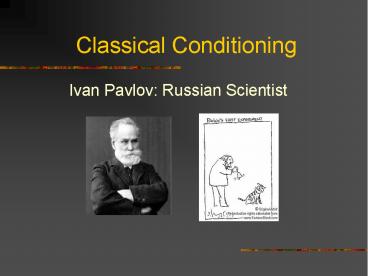Classical Conditioning - PowerPoint PPT Presentation
Title:
Classical Conditioning
Description:
Classical Conditioning Ivan Pavlov: Russian Scientist Pavlov s Apparatus Pavlov s Apparatus ctd. Pavlov harnessed a dog and placed food on the dog s tongue. – PowerPoint PPT presentation
Number of Views:491
Avg rating:3.0/5.0
Title: Classical Conditioning
1
Classical Conditioning
- Ivan Pavlov Russian Scientist
2
Pavlovs Apparatus
3
Pavlovs Apparatus ctd.
- Pavlov harnessed a dog and placed food on the
dogs tongue. What do you think the dog did? - Then, Pavlov paired the food with the sound of a
bell. What did the dog do? - Eventually, Pavlov only sounded the bell. What
was the dogs response at the sound of the bell?
4
Classical Conditioning Terms
- Unconditioned Response (UR)
- A reflexive, natural behavior (dog drooling)
- Unconditioned Stimulus (US)
- A stimulus that brings about unconditioned
response (the food) - Neutral Stimulus
- Doesnt initially bring about a response (what
was it in the Pavlovian model?) - Conditioned Response (CR)
- Happens through repeated pairings of the neutral
stimulus (bell) and the US (the food) - Conditioned Stimulus (CS)
- A previously neutral stimulus (the bell) is
paired repeatedly with an US and begins to get a
CR
5
Processes of Classical Conditioning
6
Classical Conditioning More Terms
- Trial the pairing of the UCS CS
- Acquisition initial stage in learning
- when the dog drools for the first time at only
the sound of the bell
7
Classical Conditioning More Terms
- Extinction The CR (drool) will gradually weaken
and eventually disappear when CS (bell) is
presented without the US (food) - Spontaneous Recovery the CR (drool) will
suddenly appear in response to a CS (bell) - Reconditioning when CS (bell) and US (food) are
paired together, the CR (drool) is likely to be
learned more quickly
8
Acquisition, Extinction, Recovery
9
More Classical Conditioning Terms
- Stimulus Generalization
- CR (drool) is brought about by stimuli similar to
the original CS (bell) - Stimulus Discrimination
- The ability to differentiate among related
stimuli - Higher-Order Conditioning
- A previously neutral stimulus comes to elicit a
CR when it is paired with a CS that already
produces the CR
10
Higher-Order Conditioning
11
Stimulus Characteristics that Strengthen the CR
- The more often the CS (bell) is paired with the
US (food), the stronger the CR (drool) will be. - The strongest CR occurs when the CS is presented
first and remains present throughout the
administration of the US. - A stronger US will lead to faster conditioning
than a weak one.
12
Examples of Classical Conditioning
- Classical conditioning helps explain the
development of conditioned emotional reactions
13
Examples of Classical Conditioning
- Principles of classical conditioning may help
explain phenomena that range from drug cravings
to acquired taste aversion. - Even immune-system responses can be classically
conditioned! - How have you been classically conditioned?































